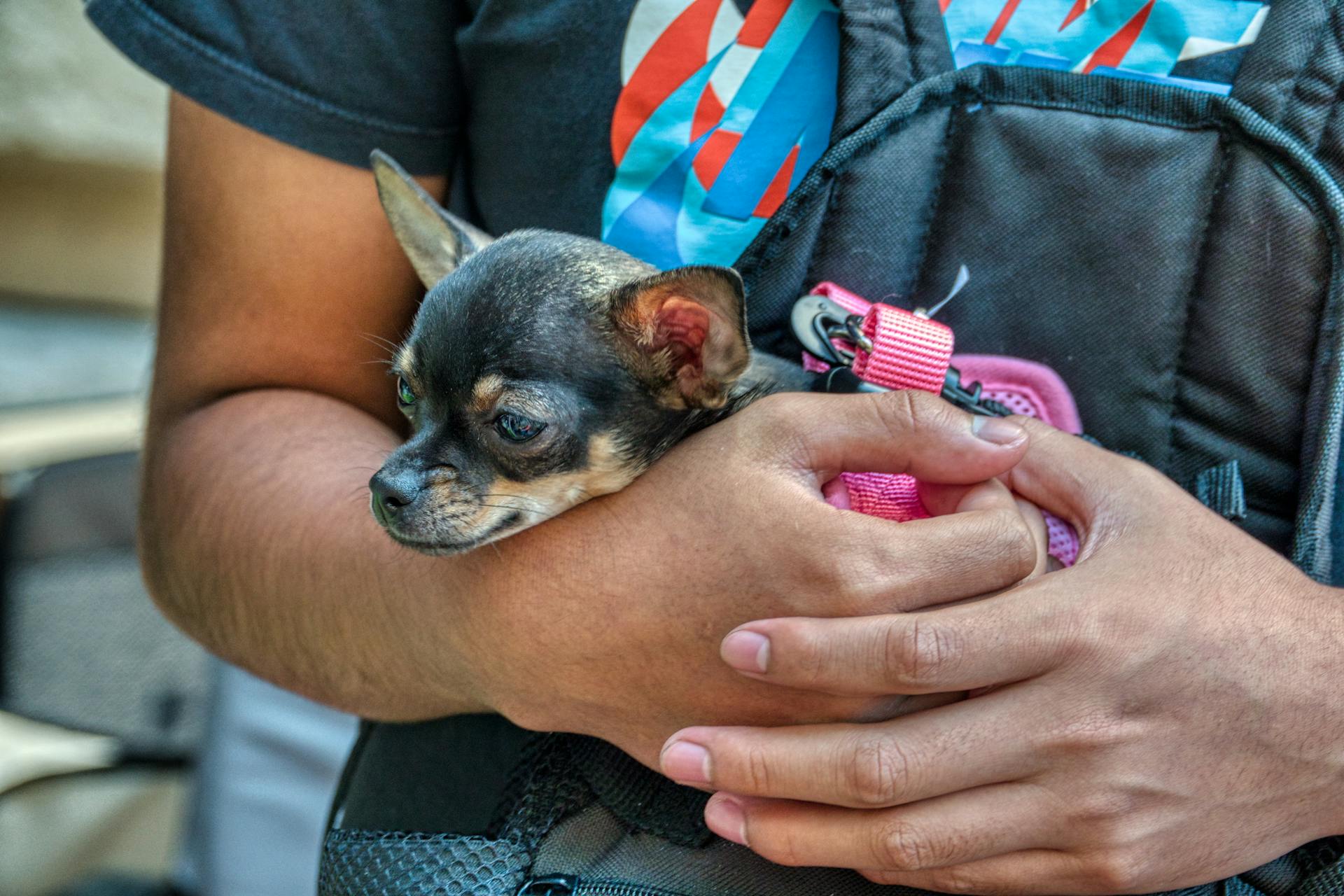
Shih Tzus can be brachycephalic, which means they have a short, flat face and can experience breathing difficulties.
Their flat face is a result of selective breeding, which has led to a shorter nasal passage and a more compact skull.
This can cause respiratory issues, especially in hot or humid weather.
Shih Tzus often exhibit symptoms such as rapid breathing, panting, and wheezing.
Understanding Brachycephalic Syndrome
Brachycephalic syndrome is a common condition affecting many breeds, including Shih Tzus. The hallmark feature of brachycephalic breeds is their "pushed-in" face, resulting from selective breeding that has shortened their skull and facial bones.
This unique anatomy compromises the space available for crucial airway structures, leading to breathing difficulties. Brachycephalic breeds like Shih Tzus have narrowed airways, elongated soft palates, and often smaller tracheas, which restrict airflow.
The anatomy of brachycephalic breeds is characterized by a compacted skull shape, leading to narrowed airways, elongated soft palates, and often smaller tracheas. This structural trait contributes to the breathing difficulties inherent to BOAS.
Readers also liked: Best Soft Food for Dogs after Dental Surgery
The most noticeable symptom of brachycephalic airway syndrome is noisy breathing, which can be accompanied by snoring, snorting, or wheezing sounds. Other common signs include exercise intolerance, labored breathing, and gagging or coughing.
Here are the top 11 signs of brachycephalic airway syndrome:
- Noisy Breathing: The most noticeable symptom is noisy breathing.
- Exercise Intolerance: Affected dogs may show a reluctance to engage in physical activities.
- Labored Breathing: Look for signs of difficulty breathing, such as exaggerated abdominal movements.
- Gagging or Coughing: Frequent gagging, retching, or coughing can occur.
- Difficulty Swallowing: Some dogs may struggle with swallowing food or water smoothly.
- Sleep Disturbance: The compromised breathing can lead to disturbed sleep patterns.
- Collapse or Fainting: In severe cases, dogs may experience episodes of collapse or fainting.
- Change in Bark or Loss of Voice: A change in the sound of your dog's bark or a loss of voice can indicate swelling or obstruction.
- Cyanosis (Bluish Gums): A bluish tint to the gums or tongue is a critical sign that your dog is not receiving enough oxygen.
- Heat Intolerance: Dogs with BOAS are particularly susceptible to heatstroke.
- Obesity: Dogs may become overweight due to their reduced activity level.
Dogs with brachycephalic airway syndrome often prefer to sleep on their backs, which allows the soft palate to fall away from the larynx.
Preventing Breathing Problems
Shih Tzus are brachycephalic dogs, which means their airways are shorter than usual. This can cause breathing problems.
Avoid walking your Shih Tzu in high temperatures because they can struggle to regulate their body temperature. High temperatures can exacerbate breathing problems.
High-intensity exercise or long walks can also be challenging for Shih Tzus. It's best to limit their exercise to shorter, more gentle walks.
Some common breathing problems in Shih Tzus include bronchial collapse, gastroesophageal reflux, and chronic gastritis.
Here are some potential breathing problems associated with brachycephalic airway syndrome:
- bronchial collapse
- gastroesophageal reflux
- chronic gastritis
If you suspect your Shih Tzu is experiencing breathing problems, it's essential to recognize the symptoms. These can range from mild to severe and may worsen over time.
Treatment and Surgery Options
Treatment and surgery are the primary options for addressing Brachycephalic Obstructive Airway Syndrome (BOAS) in dogs.
Surgery is the most effective intervention for correcting structural abnormalities such as elongated soft palates and stenotic nares, which are common in brachycephalic breeds.
The surgery is typically an outpatient operation and has evolved to be a routine and highly successful procedure thanks to advancements in veterinary medicine.
Dogs that undergo surgery often experience immediate improvement in breathing, with some owners reporting that their pets can breathe effortlessly for the first time in their lives.
Prompt veterinary care is essential for dogs showing symptoms of BOAS, as early detection and intervention can significantly enhance their health and wellbeing.
Surgery can correct underlying anatomical abnormalities that interfere with breathing, and various surgical techniques are available, including minimally invasive procedures that can improve airflow without extensive procedures.
What Is the Treatment for?
Treatment for brachycephalic airway syndrome is a multi-faceted approach that involves both conservative management and surgery.

Obesity worsens the signs of the condition, so weight loss is an important part of treatment for overweight dogs.
Controlling exercise levels, avoiding hot or humid conditions, and keeping your dog in an air-conditioned area during the summer can help manage mild or intermittent signs.
Corticosteroids, nonsteroidal anti-inflammatory drugs (NSAIDs), and oxygen therapy can provide short-term relief of airway inflammation or respiratory distress.
Surgery is the treatment of choice when anatomic abnormalities interfere with your dog's breathing.
Surgically correcting stenotic nares, shortening an elongated soft palate, and removing everted laryngeal saccules can all help improve airflow and alleviate respiratory distress.
Readers also liked: Early Signs of Diabetes in Dogs
Dog Prognosis
Dogs under two years of age at the time of surgical correction have a better post-operative prognosis than dogs that are older.
The number of anatomic abnormalities present plays a significant role in determining the prognosis for a dog with brachycephalic airway syndrome.
Dogs that only require surgical correction for stenotic nares and/or an elongated soft palate have a better prognosis than dogs with more defects.
A hypoplastic trachea can lead to a variable prognosis for affected dogs.
Proper management can significantly improve the quality of life for dogs with brachycephalic airway syndrome, even if they have a poorer prognosis.
Broaden your view: Puppy Pregnancy Syndrome
Treatment Options

Conservative management is often the first line of treatment for dogs with brachycephalic airway syndrome, focusing on controlling exercise levels, avoiding hot or humid conditions, and keeping the dog in an air-conditioned area during the summer.
Weight loss is also an important part of treatment if your dog is overweight, as obesity worsens the signs of the condition.
Surgery is the most effective intervention for correcting structural abnormalities such as elongated soft palates and stenotic nares, which are common in brachycephalic breeds.
Surgical correction can be performed using surgical lasers, making the procedure more precise and less invasive.
The success of these surgeries depends on the severity of the condition and the age of the dog, with dogs under two years old at the time of surgical correction having a better post-operative prognosis.
Here are some common surgical procedures used to correct brachycephalic airway syndrome:
- Stenotic nares correction: removing a wedge of tissue from the nostrils to improve airflow
- Elongated soft palate correction: surgically shortening the soft palate to a more normal length
- Everted laryngeal saccules removal: removing the obstruction in the larynx
With proper treatment and surgery, dogs with brachycephalic airway syndrome can lead happier, more active lives, and their owners can enjoy a better quality of life with their pets.
Other Potential Health Issues
Shih Tzus can be prone to brachycephalic airway syndrome, which can lead to some serious health issues.
Brachycephalic airway syndrome has been linked to changes in the lungs, as well as in the gastrointestinal tract.
Bronchial collapse is a common problem, where the bronchi weaken and collapse, causing further obstruction. This can make it difficult for your Shih Tzu to breathe.
Gastroesophageal reflux is another issue that can occur, where intestinal fluids flow back into the esophagus. This can be uncomfortable and even painful for your dog.
Chronic gastritis is also a potential problem, where the stomach lining becomes inflamed and irritated. This can cause stomach pain and discomfort.
Here are some of the potential health issues that can arise from brachycephalic airway syndrome:
- bronchial collapse
- gastroesophageal reflux
- chronic gastritis
Age and Breathing Problems
Shih Tzus can develop respiratory problems due to their brachycephalic nature, which can worsen with age.
BOAS, or Brachycephalic Obstructive Airway Syndrome, can put a lot of pressure on the respiratory system, leading to inflammation and secondary problems.
Take a look at this: Are Chihuahuas Brachycephalic
As a Shih Tzu ages, its BOAS problem is likely to worsen if left untreated, especially if the dog gains extra weight.
Exercise and high temperatures can exacerbate breathing problems in Shih Tzus, so it's essential to minimize these factors to reduce the effects of BOAS.
BOAS surgery is a treatment option that can help improve breathing in Shih Tzus and improve their quality of life.
Sources
- https://www.hepper.com/do-shih-tzus-have-breathing-problems/
- https://vcahospitals.com/know-your-pet/brachycephalic-airway-syndrome-in-dogs
- https://www.ccpet.com/services/dogs/blog/uncovering-brachycephalic-obstructive-airway-syndrome-dogs
- https://www.cinderrockvetclinic.com/site/blog/2024/04/30/brachycephalic-airway-syndrome-dogs
- https://southerncrossvet.com.au/shih-tzu-breathing-easy-boas/
Featured Images: pexels.com


